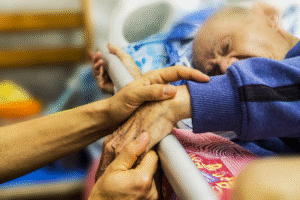A sudden heart attack demands immediate action. Heart attacks can be treated right on the scene by friends, family members, and caregivers present in the area with some quick thinking and calm decision-making.
What is an AED?
An Automated External Defibrillator, or AED, is a device used to immediately treat victims of cardiac arrest. The device uses an electric shock to “wake up” the heart so it can resume its regular heartbeat rhythm.
When to use an AED
AED’s should only be used after attempting to revive an individual with CPR. First, identify if the individual is still conscious or not. Ask “are you OK?” in a loud voice while clapping or tapping the person’s arm. Have a friend or family member call 911 while you begin CPR.
If you are alone, always call 911 first unless you are dealing with a victim of drowning or suffocation. It is imperative to deliver immediate CPR to someone who is unresponsive because of suffocation.
Check out our blog post on administering CPR safely for an overview of proper techniques. You should perform up to five cycles (One cycle: 30 chest compressions, 2 rescue breaths) before using an AED, if available. If you have access to an AED, administer a single shock, then continue CPR. If no AED is available, continue administering full cycles until help arrives.
In the state of Nebraska, AEDs can legally be used by anyone, regardless of training or previous experience.
How to Locate an AED Nearby
 Every second matters when dealing with a victim of cardiac arrest. If you are in public, look for signs that would indicate where to find the device. Many schools, gyms, and doctor’s offices are required to keep the devices onsite. Other local establishments such as restaurants, government buildings, and offices commonly keep AED’s in the event of an emergency.
Every second matters when dealing with a victim of cardiac arrest. If you are in public, look for signs that would indicate where to find the device. Many schools, gyms, and doctor’s offices are required to keep the devices onsite. Other local establishments such as restaurants, government buildings, and offices commonly keep AED’s in the event of an emergency.
- Symbols with the heart shape, electricity or lightning bolts.
- The abbreviation AED, which is universally accepted beyond medical settings.
Administering the First Shock with an AED
Before administering the first shock with an AED, remember:
- Never operate an AED under the effects of alcohol or drugs.
- Never operate an AED in an explosive environment.
- Never operate an AED near puddles or sources of water.
- Never touch a patient when the shock is administered.
Try to stay calm. AEDs can be used without any prior training. The devices are designed in a way that is easy to understand and use, even under great duress.
Expose the person’s bare chest to attach the electrode pads. The device will indicate exactly where to place the adhesive pads on the unconscious individual. Ensure that the adhesive AED pads are attached to a cable which is plugged into the machine. After giving the first shock, check to see if the victim is breathing again. Inspect the individual’s airway again and provide CPR rescue breaths if needed.
A Place at Home specializes in providing Compassionate Care delivered by Passionate Professionals, including urgent care. Our skilled caregivers advocate for the health and wellness of those who want to remain in the comfort of their own homes.




